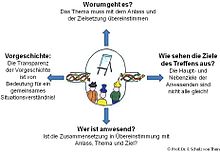Situation model (Schulz von Thun)
The situation model is one of the six models of Hamburg communication psychology based on Friedemann Schulz von Thun . It shows that four components are important in order to grasp the truth of the situation (→ coherence ):
- The entrance channel stands for the previous history and for the given occasions that led to the situation. In many cases, human encounters and conversations do not take place spontaneously and unintentionally, but take place, especially in the professional field, on the basis of an appointment or an invitation. In order for the meeting (the meeting, the exam, the event, the conversation) to take place at all, occasions are given in advance and forces are effective. Questions that shed light on this component are, for example: "What was the reason for this meeting? Who invited on whose behalf? What preceded the meeting in terms of preliminary clarifications, telephone calls, preparatory discussions? Who with whom and what results?" Sometimes every participant of the meeting has his own history, known only to him. Then it is usually worthwhile to clarify the personal background of the attendance in an initial round.
- The upper abdomen represents the thematic structure . This means: "Which topics bring us together? What is on the agenda? What is part of our task, what is not? In which sub-aspects is the general topic structured? What is thematically given, what is still to be raised here among us? With one word: What is it about? " The topic has to be in accordance with the occasion and the objective, otherwise something is wrong.
- The lower abdomen stands for the interpersonal structure of those involved, namely: "Who is present, who has come together here? Why this one and no others? In what role, in what role, with what interest, on whose behalf? Is the composition consistent, that is, in accordance with the occasion, topic and objective? Who is absent? Why? Which of those present is unclear why or what he is there for? " In this context, the role (represented as a hat) that the people play is of great importance. Because it is this situational role that shapes my idea of what my contribution to a situation should be and how it should be presented.
- The output channel represents the goals of the meeting, what should come of it, e.g. B. a decision, an agreement, a concept, a common information stand, etc. The main and secondary goals that those present will bring into the meeting will not all be the same, so the network of goals is symbolized as a tangle of threads. To facilitate communication that is appropriate to the situation, it is useful if the leader sets out his objectives of the meeting in a binding manner and compares them with the objectives of those present.
With the help of the situation model, an attempt is made to capture the sum of all those circumstances that are contained in the situation, define their focus and influence the psychological reality of those present. With this knowledge it can e.g. B. To handle conversations, discussions and gatherings in a situation-logical and system- appropriate manner.
literature
- F. Schulz von Thun: Talking to one another 3. The inner team and situation-appropriate communication Chapter 6. Reinbek near Hamburg, 1998 (p. 13 ff ./306 ff)

